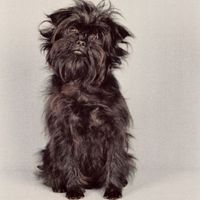
Pyrenean Mountain Dog / Great Pyrenees

Breed history:
Like all the mountain dogs it also descends from the Tibetan Mastiff brought to Europe by migratory peoples in the 5th century. It is considered to be related to the other shepherd dogs in Europe (Kuvasz, Maremma Sheepdog). It is considered to be a relative of the Saint Bernard or of the Newfoundland. It was a loved companion dog of the French nobility in the 17th century. In 1824, General Lafayette described this dog to an American friend in the most laudatory terms.
Description:
It is a large-sized, strong, elegant and athletic dog. The head is trapezoidal, with the muzzle equal in length to the skull and with a big, black nose. The eyes are medium-sized, slanting and light brown. The ears are V-shaped, small and drooping. The tail is long, bushy, kept low at rest and on the back when alert. The fur is double-layered, with an outer layer of medium length, thick, white or white with brown patches, grey or light yellow. The hair is longer on the tail and neck where it forms a mane.
Personality:
It is a peaceful, well-balanced, brave, intelligent dog. Loyal and devoted to its master, it accepts and even loves children. Protective, territorial, even aggressive towards large dogs, it doesn't have any problems with small dogs, or with other animals. It is cautious and reserved with strangers. Sometimes it can be difficult, even stubborn, tends to be nocturnal (resting during the day and guarding at night).
Grooming:
This dog's fur requires regular brushing and more frequent during the shedding period.
Living conditions:
This dog is resistant to weather changes, and feels best in the open with the possibility of getting lots of exercise (it doesn't like to be chained) with an active family. It can also be raised in a large house if it gets lots of daily exercise. It needs training and socialization.
Training:
They need to be trained from an early age, to understand what the master requires of them. When they reach maturity, they start to exhibit independence, even stubbornness and are harder to train. The training must be firm, consistent, but in a gentle and loving voice.
Usefulness:
It is used in the mountains to guard and protect livestock against bears and wolves. It is a gentle and devoted companion.


Austrian Shorthaired Pinscher
Austrian Pinscher, Osterreichischer Kurzhaarpinscher, Österreichischer, Österreichischer Pinscher





